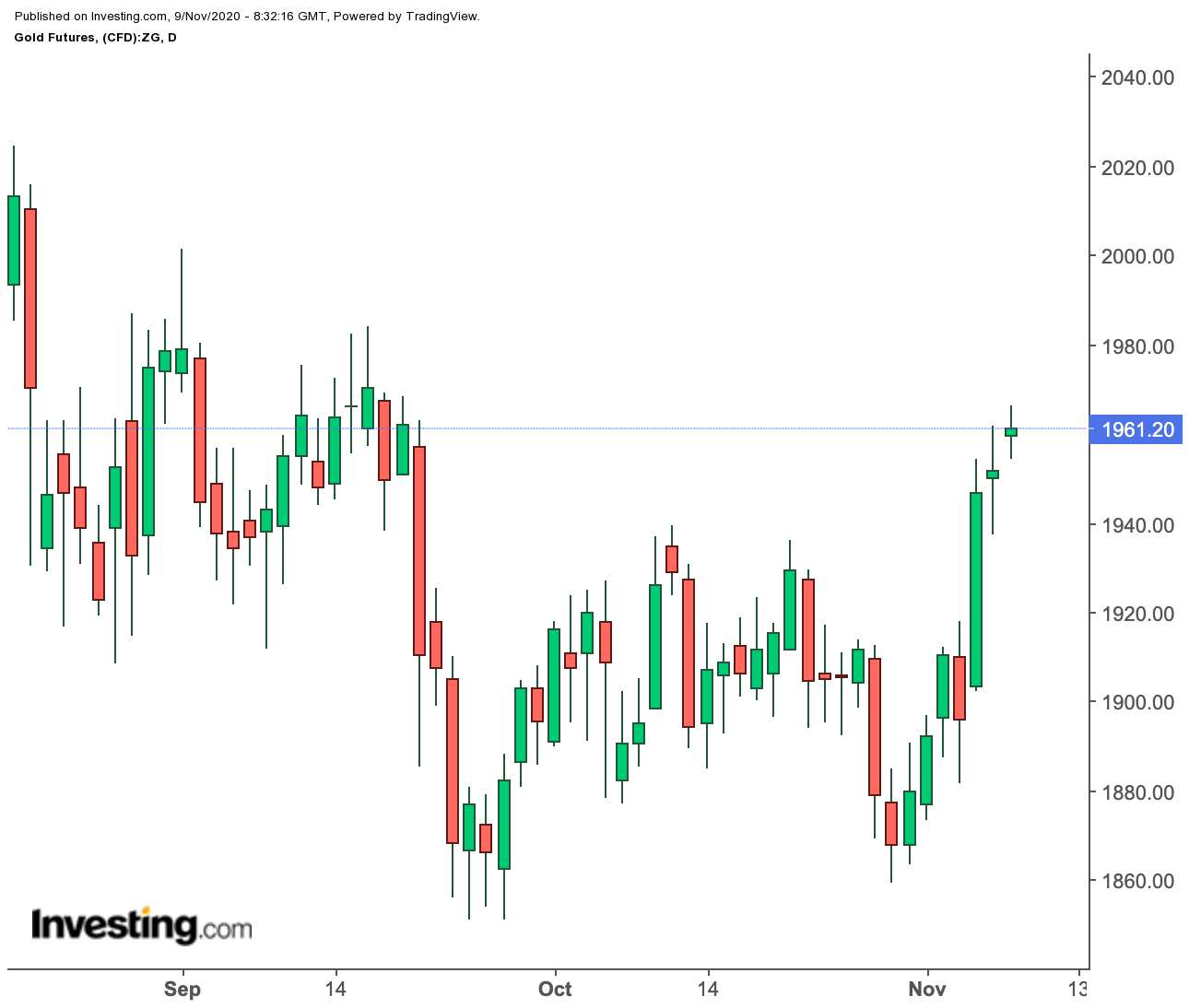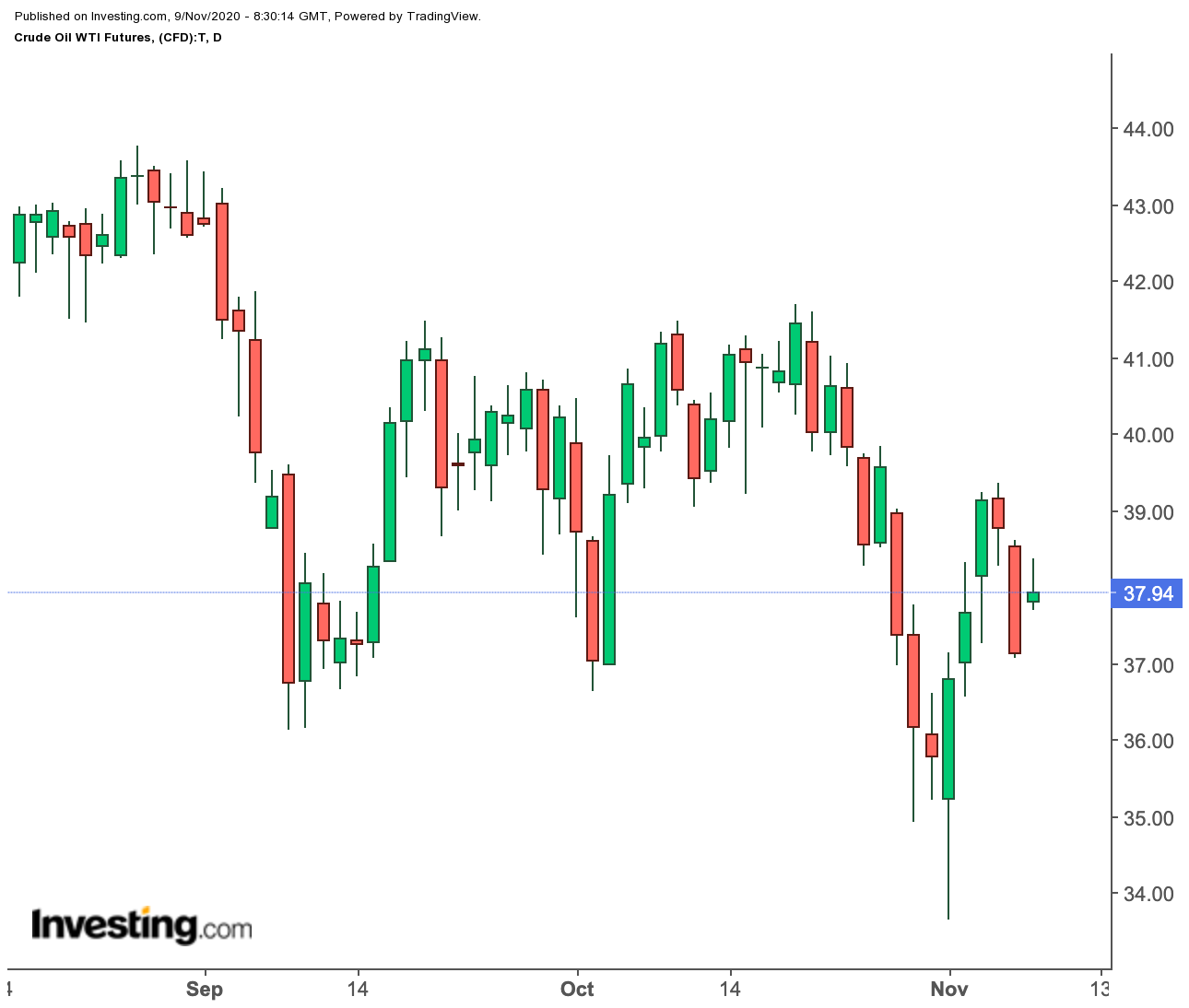Hope and fear—gold and oil take their cue from diverging drivers this week, as the incoming Joe Biden presidency spells different outcomes for the two most active markets in commodities.
A relief rally is expected at the U.S. open on Monday after Election 2020 passed with surprising calm compared to the civil war-like aftermath many in the United States had feared. Dow futures were up 1.5% by 12:00 AM ET (0500 GMT) and Asian markets rose substantially also.
If risk-on in U.S. stocks moves into full-blown rally mode for the rest of the week, the dollar’s standing as a haven currency could take a harder knock, delivering a boon to gold bugs.
The dollar has had more blowouts than breakdowns in the last three months, virtually killing gold’s chance of reprising its August record high of nearly $2,080 an ounce. Conversely, a tanking dollar now could give gold upside velocity not seen since the third quarter.
In Monday’s session, U.S. gold for December delivery hit an eight-week high of $1,965.65. By 12:00 AM ET (0500 GMT), it was trading at $1,964.35 up $12.65, or 0.7%, on the day. The benchmark gold futures contract rose 3.8% last week.
Spot gold, which reflects real-time trades in bullion, was up $12.05, or 0.6%, at $1,963.26. It hit an eight-week high of $1,964.76 earlier.

Gold Eyes Post-Biden Inauguration Stimulus
Gold traders are closely watching for signs of any initiative by the incoming Biden administration and Democrats in Congress to resume coronavirus stimulus talks with Senate Republicans during the lame-duck session before the Jan. 20 inauguration of the new president.
For context, congressional Democrats reached agreement in March with the Trump administration and senate Republicans to pass the Coronavirus Aid, Relief and Economic Security (CARES) stimulus. That package dispensed roughly $3 trillion as paycheck protection for workers, loans and grants for businesses and other personal aid for qualifying citizens and residents.
Since then, the two sides have been locked in a stalemate on a successive relief plan to CARES. The dispute has basically been over the size of the next stimulus as thousands of Americans, particularly those in the airlines sector, are at risk of losing their jobs without further aid.
House Speaker and top Congressional Democrat Nancy Pelosi told reporters on Friday her next immediate priority was to cajole members of the Trump administration to resume COVID-19 stimulus talks disrupted by the election.
Pelosi has not wavered from her demand that the stimulus must be at least $2 trillion for a country that has logged over 10 million COVID-19 cases and more than 237,000 deaths from the virus, and is still seeing a record 100,000 new infections a day.
But Senate Majority Leader and top Republican Mitch McConnell has indicated that he will continue fighting Pelosi’s plans for a large stimulus. He pointed to economic statistics, including a recent 1% point drop in the U.S. unemployment rate, as warranting a smaller stimulus.
If McConnell’s comments—and history—are a guide, achieving anything meaningful during the lame-duck will be next to impossible between two sides with so much scorn for each other.
Yet, Biden’s moderate and unified approach might appeal to some Republicans and soften the rigid demands of some of his own Democrat colleagues, including House Speaker Nancy Pelosi.
So gold bulls can’t be faulted for hoping for stimulus talks that would at least lay the ground for a fiscal plan that could pass muster with the Senate in January.
Oil Rallies Too, Though Risks Weigh
Oil prices also rose Monday as the Democrats’ failure to immediately win control of Congress heartened oil bulls fearful of Biden’s anti-fossil fuels stance.
West Texas Intermediate, the leading indicator for U.S. crude, was up $1.05, or 2.8%, at $38.19 per barrel by 12:00 AM ET (0500 GMT). Last week, WTI jumped 3.8% rebounding strongly from a mid-June low of under $33.64 hit earlier in the week.

London-traded Brent, the global benchmark for crude, gained $1.04, or 2.6%, to $40.49 per barrel. Brent rose 5.3% last week.
"Trading this morning has a risk-on flavor, reflecting increasing confidence that Joe Biden will occupy the White House, but the Republican Party will retain control of the Senate … The outcome is ideal from a market point of view. Neither party controls the Congress, so both trade wars and higher taxes are largely off the agenda," Michael McCarthy, chief market strategist at CMC Markets in Sydney told Reuters.
The immediate threat to oil is the market’s concern on “how green” the Biden Plan for energy will be. The president-elect has said his $2 trillion proposal will be narrower and less aggressive than the Green New Deal of the Democratic far-left that aims to aggressively tackle climate change and issues such as social justice, jobs, housing and healthcare.
To many oil traders, the bottom line is whether Biden’s policies will put a great squeeze on fracking and ultimately shut down fossil fuels for renewables.
The long answer is yes, but that’s unlikely to happen anytime soon. In fact, given his centrist approach, Biden is unlikely to rock the energy boat greatly, and there are doubts whether there’ll even be a major disruption to oil production by the end of his first term.
For the record, the incoming president has committed to prohibit only permits for new oil and gas drilling on federal land and waters. Expert legal opinion is that a broad ban on new drilling permits or even lease sales would be difficult for him to impose immediately.
But there’s also a genuine fear that Biden would be less friendly to the Organization of Petroleum Exporting Countries than his soon-to-be-predecessor Trump. In a 180-degree turn, Trump went from breathing down OPEC’s neck pressuring for lower oil prices before the 2018 midterm election, to rescuing the cartel during the market's worst ever crisis in March that took crude to minus $40 per barrel.
Energy ministers from Saudi Arabia, Russia, Iraq, Iran, UAE along with OPEC's Secretary General will be speaking at the Abu Dhabi International Exhibition & Conference this week, along with corporate representatives from BP (NYSE:BP) and Total.
OPEC and non-member allies under the extended OPEC+ alliance are in the midst of deciding the future of output cuts. For now, their pre-planned rollback of production cuts appear dead in the water given the renewed slide in oil demand and prices in recent weeks.
Goldman Sachs said in a note:
“Today, the challenges in the oil markets are far more demand-driven, with OPEC production now at 24-25 million barrels per day vs. 32 mn bpd in 2015.”
“Most investors we speak to expect a 3-6 month extension of the production quotas versus the 2 mn bpd increase in production that was initially planned for before lockdowns re-accelerated in Europe. While this likely provides a near-term floor for spot crude prices, higher OPEC+ spare capacity remains a challenge.”
Another major fear among oil traders is how quickly Biden could bring back the Obama-era nuclear deal with Iran, to allow Tehran to resume oil exports that the Trump administration had practically shut down over the past two years through sanctions.
A Tehran freed from sanctions could easily add between one million and two million barrels of oil per day to global production, seriously impacting crude prices in a market that continues to suffer from low demand due to the COVID-19 pandemic. Already, output has been ramping in Libya, another major OPEC member that has returned to the market in a big way since a peace deal struck with domestic warring factions last month.
While sanctions on Iran will remain through the end of Trump’s term, the remotest possibility of the Islamic state’s oil returning to the market right after that could weigh on crude prices, complicating a return to $40 levels.
Also weighing on oil in the near term will be tightening of COVID-19 safety measures that could limit social activity and demand for oil. Biden, in his first president-elect speech on Saturday, said he was putting together an interim coronavirus taskforce, signaling stricter adherence to safety versus the relaxed approach to the pandemic taken by the Trump administration.
